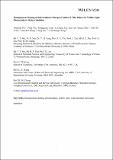Homogeneous doping of substitutional nitrogen/carbon in TiO2 plates for visible light photocatalytic water oxidation
Abstract
Extending the light absorption range of wide‐bandgap photocatalysts into the visible light region is significant in terms of fully harvesting and converting solar light. The desirable band‐to‐band redshift of the absorption edge of semiconducting binary metal oxides such as prototypical photocatalyst TiO2 by doping is long targeted but remains a challenge, up to date. Here, by taking the advantage of abundant 1D diffusion channels with rhombus‐like cross‐sections along the c‐axis in the crystal structure of titanium oxalate hydrate to promote the entrance of nitrogen dopant species into the bulk and subsequent thermal topotactic transition in an atmosphere of gaseous ammonia, homogeneous doping of substitutional carbon/nitrogen for oxygen in the TiO2 decahedral plates with a dominant anatase phase is obtained for the first time. The resultant TiO2−x(CN)y with an unusual band‐to‐band visible light absorption spectrum can induce photocatalytic water oxidation to release oxygen under visible light irradiation. This study provides not only a promising visible light–responsive TiO2 photocatalyst, but also an important strategy for developing other solar‐driven photocatalysts.
Citation
Wu , T , Niu , P , Yang , Y , Yin , L-C , Tan , J , Zhu , H , Irvine , J T S , Wang , L , Liu , G & Cheng , H-M 2019 , ' Homogeneous doping of substitutional nitrogen/carbon in TiO 2 plates for visible light photocatalytic water oxidation ' , Advanced Functional Materials , vol. 29 , no. 25 , 1901943 . https://doi.org/10.1002/adfm.201901943
Publication
Advanced Functional Materials
Status
Peer reviewed
ISSN
1616-301XType
Journal article
Description
The authors thank National Natural Science Foundation of China (Grant Nos. 51825204, 51572266, 21633009, and 51629201), the Key Research Program of Frontier Sciences CAS (QYZDB‐SSW‐JSC039) for the financial support. G.L. is grateful for the award of the Newton Advanced Fellowship.Collections
Items in the St Andrews Research Repository are protected by copyright, with all rights reserved, unless otherwise indicated.

